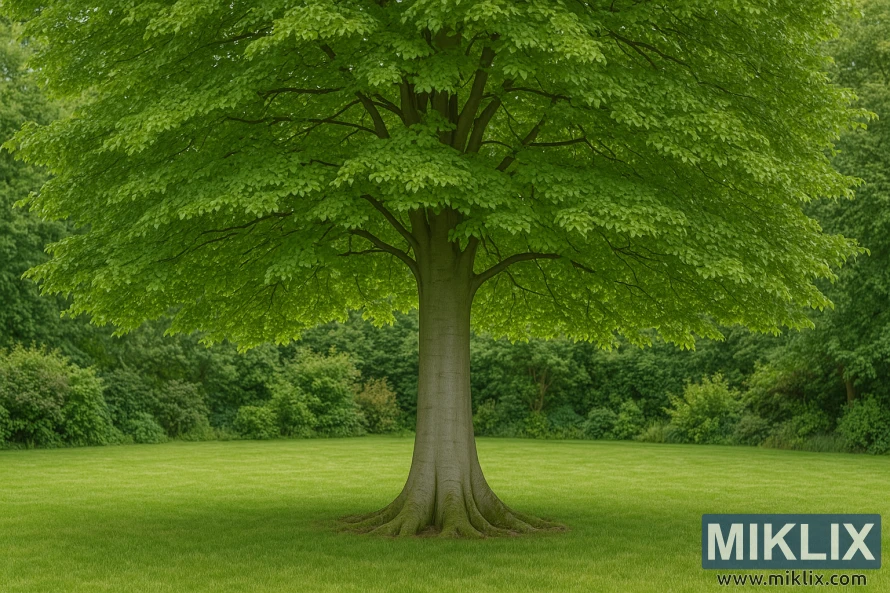Image: European Beech Tree
Published: August 28, 2025 at 10:13:39 AM UTC
Last updated: September 28, 2025 at 8:31:08 AM UTC
A mature European beech with smooth gray bark and broad canopy stands on a lush lawn, offering elegance, shade, and ornamental beauty.
In this serene garden landscape, a mature European beech tree (Fagus sylvatica) stands with an elegance that commands admiration while offering a profound sense of tranquility. Its smooth, gray bark, free of fissures and rugged texture, provides the trunk with a refined, almost polished appearance that sets it apart from many other species. This visual softness contrasts beautifully with the sheer strength suggested by the trunk’s steady rise and the strong, flaring roots at its base. These roots, curving outward into the lawn, give the tree an air of permanence, as though it has long claimed its place in this landscape and will continue to anchor it for generations to come.
The canopy above is perhaps the tree’s most striking feature—a vast, symmetrical dome of dense, vibrant foliage that spreads outward in all directions. Each broad leaf contributes to the fullness of the crown, together forming a lush green umbrella that dominates the scene with its breadth and grace. The canopy’s symmetry creates a sense of natural order, a living architecture that feels both deliberate and organic. It casts a wide circle of shade beneath, transforming the ground below into a sheltered retreat where light is softened and the air feels cooler. This natural canopy effect has long made beech trees cherished in gardens and parks, where their shade provides both comfort and aesthetic harmony.
The lush, manicured lawn that surrounds the tree enhances its stature, offering a broad expanse of green that accentuates the beech’s commanding form. The simplicity of the grass foreground allows the eye to focus entirely on the tree, highlighting the interplay of trunk, roots, and crown without distraction. In the distance, a backdrop of varied shrubs and mixed greenery frames the composition, their deeper tones providing contrast to the vivid canopy. These background layers also add depth to the scene, suggesting that while the beech tree is the clear centerpiece, it exists within a larger ecosystem that supports and balances its grandeur.
Part of the European beech’s enduring appeal lies in its year-round beauty and adaptability to the seasons. In spring and summer, as shown here, its foliage forms a glowing dome of fresh green that radiates vitality. In autumn, those same leaves transform into rich hues of copper, amber, and gold, creating an entirely different but equally stunning display. Even in winter, when the branches are bare, the beech retains its elegance, with the smooth silver-gray bark and graceful structure of the branches ensuring that it remains an object of beauty in the landscape. This seasonal versatility is one reason the species is considered one of the finest ornamental trees for large gardens, estates, and public parks.
The tree’s presence in this image embodies both strength and serenity. Its form is monumental yet inviting, stately yet approachable. It is easy to imagine the beech as a focal point for reflection or gathering, its broad canopy offering shade for quiet contemplation, leisurely picnics, or simply moments of stillness beneath its branches. The scene suggests that the tree is more than just a feature of the garden—it is a presence, one that shapes the atmosphere of the space with calm authority.
This image beautifully illustrates why the European beech has long been celebrated as a symbol of endurance and elegance. Its harmonious balance of smooth bark, powerful roots, and expansive foliage makes it not just an ornamental choice, but a living sculpture, a centerpiece around which a landscape can be designed. The mature specimen depicted here stands as a testament to the artistry of nature and the timeless appeal of trees that combine strength, beauty, and resilience in a single form.
The image is related to: Best Beech Trees for Gardens: Finding Your Perfect Specimen

